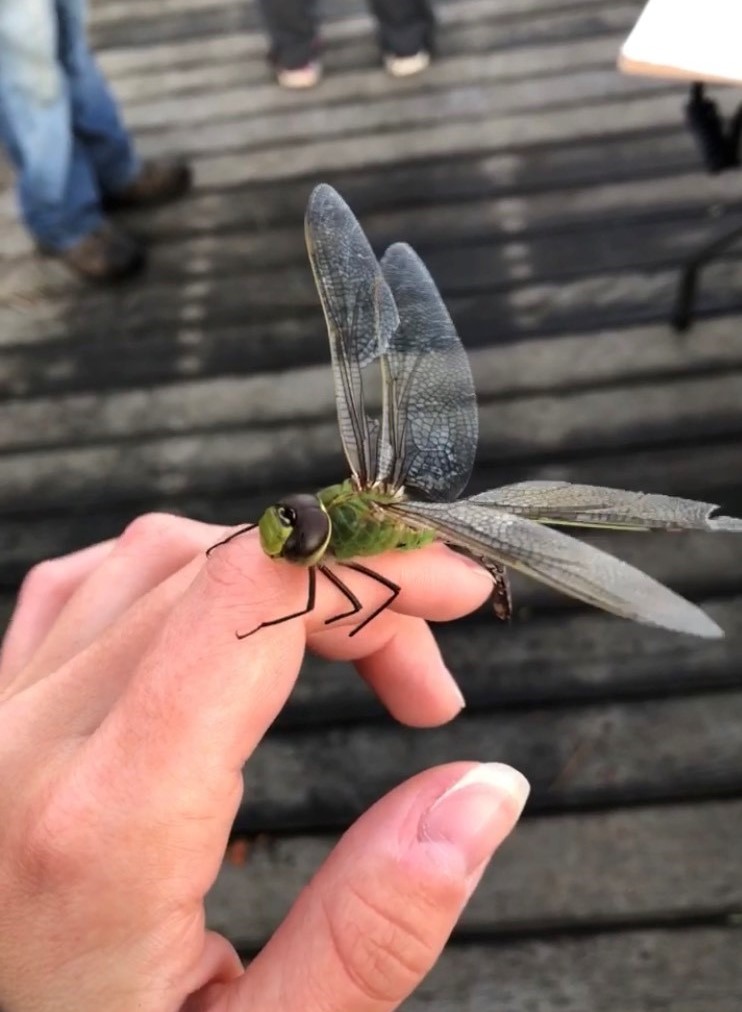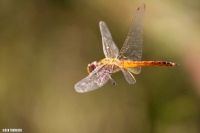For anyone that has experienced similar foraging flights of dragonflies, especially during migration, you know how intense yet fleeting these interactions are. The dragonflies will congregate in one area, dipping and diving and somehow avoiding colliding with one another in their seemingly blind frenzy. If you focus in on one you can even watch it pluck unlucky mosquitoes out of thin air – queue “Flight of the Bumblebee,” only more akin to the rough energy of a group of tiny fighter jets.
After these moments of mad hustle and bustle, the cloud of energy disperses. Take a moment to wave goodbye as these insects continue on their journey southward, because we will begin to see less of them as summer draws to a close and autumn sets in.
The Common Green Darner (Anax junius) is one of a few species of migratory dragonfly in Wisconsin that we begin seeing in early spring, and that we begin saying goodbye to in late summer. It is likely a dragonfly, if not the dragonfly, people think of when presented with the term, and is unmistakable. Not only are they large and easy to spot, but their presence is commanding as they patrol their territories and hover overhead.
When some species are described as migratory, there is a brief pause I often take when I think oh – but I still see American Robins in my yard in the winter, didn’t they leave? And then I tell myself yes, they are migratory, but some of them are partially migratory. Meaning some stay, some go. Well, this is also the case with Common Green Darners and a few other dragonfly species. Unlike the robins, though, dragonflies won’t be eating blueberries from your yard in the dead of winter. Instead they’ll be hunkering down in some shallow body of water as a nymph. Brrr! The resident adults lay their eggs in the summertime, which then hatch and begin developing into larval instars until temperatures drop too low and they transition to overwintering until spring. Meanwhile, the southbound migrants emerge from their nymphal phase toward the end of summer and begin their journey almost straight away.
More research needs to be done to find out exactly where all these dragonflies go (and why – can’t they save energy and all overwinter here?), but it is known that they end up around the southern coast and into the Gulf of Mexico. Such an impressive migration for such a small creature! It is similar to the migration of the Monarch butterfly, though the Common Green Darner takes two generations to make it south and back as opposed to the sometimes-four of the Monarch. Even though both of these migrations are incredible feats of flight, they are child’s play compared to the migration of the Wandering Glider, a dragonfly also known as the “Globe Skimmer.”
The Wandering Glider (Pantala flavescens), pictured at the top of this post, is in the Skimmer family, and is probably the most widespread species of dragonfly on the planet. This species is found on almost every continent (save for Antarctica) and has been discovered traveling across the ocean from India to Southeastern Africa, island hopping along the way. This migration of the Wandering Glider is typically split between three generations and covers over ten thousand miles – that’s over three thousand miles per generation! Imagine traveling from the east coast of the US to the west coast – that’s roughly three thousand miles. Now imagine you’re tiny – about the size of a crayon (or a mini sharpie if we’re getting specific), carried by tissue paper wings, and all the land beneath you is actually water. Incredible? I’d say so.
In my experience it seems the Wandering Gliders never land. When they start showing up later in the season they’re busy flying overhead, rarely taking a moment to rest. I’ve only netted a couple, and they proved acrobatic displays. Migratory species like the Wandering Glider and Common Green Darner are morphologically built to better handle sustained flight. Their hindwings are typically broader than the forewings, allowing them to soar and expend less energy over time. Sometimes, very late into the season, come October or so, you’ll be able to see dragonflies with tattered wings and duller colors. These are likely old dragonflies that won’t be migrating all the way south, but just stop for a second to imagine where they’ve been and all that they’ve seen in their short lifetime.

Some of the dragonflies’ experiences end in the mouths of migrating birds, such as the American Kestrels, who have learned to capitalize upon dragonfly migration. Both the Kestrels and the Common Green Darners have been observed migrating together, creating a buffet of sorts on the way. Other dragonflies end up face-first in our bird banding nets that are set in early autumn to catch songbird migration, who are then untied and set free as best as possible. The lucky ones manage to avoid these obstacles and finish their migration southward with only the elements to battle.
Next time you see a group or swarm of larger dragonflies, especially this time of year along the Lake Michigan coastline, stop to observe their ephemeral nature as they float in and out of an area, not unlike like the ebb and flow of waves onto the very shore they’re adorning.
Photo Credits: (1) Wandering Glider, Pantala flavescens, by Rison Thumboor, shared with permission, no modifications made (https://creativecommons.org/licenses/by/2.0/); (2) Common Green Darner, Anax junius by Maggie Steinhauer





